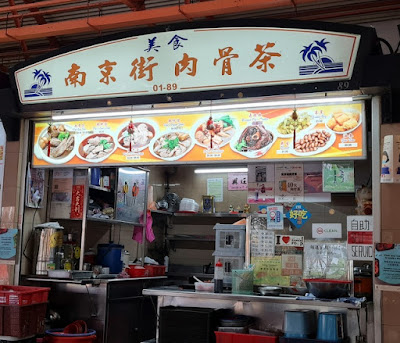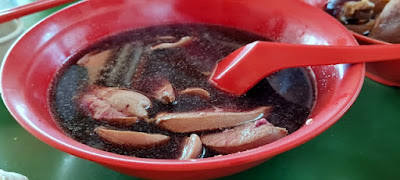A quick translation of the text, thanks to Nicole:
日本に比べると物価や交通费がまだまだ低いシンガポール。今回は50シンガポールドルの予算でこの国のパイオニアたちがい築た街チャイナタウンに遊びに行ってみた。
Singapore has lower prices and transportation costs than Japan. This time, with a budget of 50 Singapore dollars, went to Chinatown, a city built by pioneers in this country.
At Maxwell Hawker Centre.
In the old days, Bak Kut Teh (Rou Gu Cha) could be found along the streets by hawkers, mainly on push carts and later in coffeeshops. When Singapore underwent massive urban renewal, these hawkers and even the stalls in the coffeeshops were offered locations in the hawker centres to continue their business. Gone were the luxuries (to some) where hawkers would be pushing their carts right to one's front door and one could order and even collect the food by lowering a basket from the upper storey.
Nanjing Road Bak Kut Teh has an interesting history. Old Auntie at Maxwell Food Centre was telling us how when the Bak Kut Teh stall at Nankin St was giving up, the boss offered her to take over. And she brought it to Maxwell Food Centre in 1989.
Thanks to Yan Chen who shared with me this photo, it showed what Nanjing Bak Kut Teh stall was like when it started business at Maxwell Food Centre. Auntie was sharing with us how the loyal customers followed from Nankin Street to Maxwell Food Centre, Towkays and Coolies. New customers came. In the early days of many constructions around Maxwell Food Centre area, the Construction Towkays, Kapala (supervisors) and coolies also came to enjoy Bak Kut Teh, a source of protein and energies for the perspiration draining work in the hot sun.
When Maxwell Food Centre underwent major renovation, the stalls became bigger and the space was more hygienic. Progressing till today, there were also proper arrangements by NEA (National Enviroment Agency) to ensure cleanliness of the food centre. Latest regulations require patrons to return the used crockery to the "tray station".
The current stall
It was in Maxwell Food Centre that Auntie added a variety of side dishes to the main Bak Kut Teh. Now you can get pickled vegetables and boiled peanuts. There were also the pig trotters and innards (we call them spare parts) of kidney and liver, one of the best, if not the best one in town. Auntie is very meticulous in ensure that they are properly cleaned before cooking. And the formula for the soup, it is a "trade secret" (the expert might be able to sus out the possible ingredients). It has been the same ever since she started the business. She is very loyal to the original recipe and taste and so she does not change the supplier nor the ingredients. Because the ingredients used are organic, there will be changes in taste over time, depending on the farm environment. So far, it has not deviated much, according to old timers.
Kidney & Liver Soup
Bak Kut (pork bones)
We were also discussing on the boiling of the Bak Kut with gas fire and charcoal fire. It has long been discussions with those who enjoyed traditional Chinese cooking using wood fire, charcoal fire, gas fire and now electric! The taste of the meat, its tenderness is different with different heat. Something to learn more from Auntie.
The Chinese gongfu tea is synonymous with Bak Kut Teh. Previously there were portable (moveable) gas-stoves (earlier charcoal stove) for boiling water to brew the tea by the patrons. The tea leaves are mostly from Pek Sin Choon, a tea company that started business in Singapore since 1925, who has blended the Nanyang Tea for Bak Kut Teh. Despite not being allowed to have the stoves any more, the stall provides hot water from a main boiler. It is a little problematic in that one has to go often to refill the teapot with hot water. But at least, one still could enjoy Nanyang Tea with Bak Kut Teh.
Bak Kut + Teh
Many of Auntie's old customers have "gone home". While there are still new customers, including many expatriates (from USA and Europe to Japan and Korea) and tourists (during pre-covid), the next question would be whether there is anyone who could take over and follow faithfully Auntie's recipe? An intangible cultural heritage that could disappear, especially with the old taste. Bak Kut Teh will evolve, and the taste will change over time, in various ways, the innovation of the sellers, and in another the demands of the patrons. Will there be anyone willing and wanting to have the old taste?
Enjoy this old taste while you can!
#bakuteh #bakkutteh #nanyangtea












